You’ve likely experienced the frustration of watching delicate filigree wires melt away or granules refuse to fuse properly during soldering. The difference between success and disaster often comes down to mastering precise temperature control—a skill that separates amateur attempts from professional-quality work. Understanding the exact temperature ranges for different metal alloys isn’t just helpful; it’s absolutely critical for achieving the flawless results that make filigree granulation truly shine.
Understanding Temperature Requirements for Filigree and Granulation Work
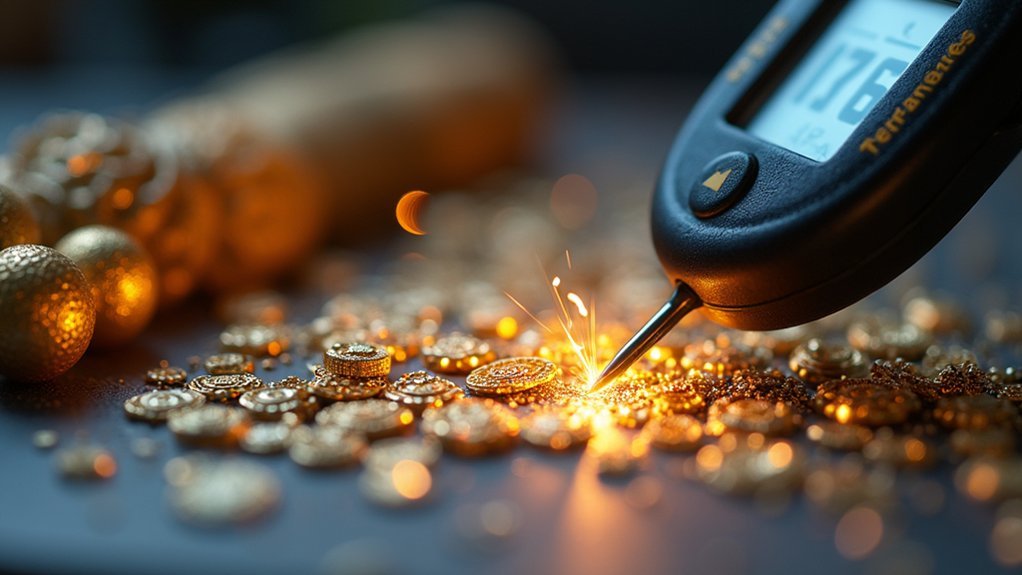
When working with filigree and granulation techniques, you’ll discover that precise temperature control separates successful pieces from damaged ones. Overheating compromises your gold granules’ integrity and color, making accurate soldering temperatures essential for quality results.
You’ll need to understand specific melting points for different materials. Argentium silver’s solidus temperature of 1410°F and liquidus of 1610°F allow effective fusing at lower temperatures than traditional sterling.
For granulation work, 22k gold’s broader melting range provides more forgiving temperature control compared to 24k gold’s narrow window.
Choose your solder carefully—lead-based options melt at lower temperatures than lead-free alternatives, vital for delicate filigree designs.
Master liquid phase diffusion bonding during heating to enhance granule adhesion without additional materials, achieving superior results through proper temperature management.
Essential Tools for Precise Heat Control in Fine Metalwork
Although temperature knowledge forms the foundation of successful metalwork, you’ll need the right tools to translate that understanding into precise heat control. Your soldering technique depends heavily on equipment that delivers consistent, manageable heat within the ideal temperature range.
Mastering temperature control is meaningless without the proper tools to achieve consistent, precise heat application in your metalworking projects.
Essential tools for achieving professional results include:
- High-quality soldering iron with adjustable settings – Provides precise control for delicate filigree work requiring specific temperatures
- Propane-oxygen torch – Delivers concentrated flames for accurate heating of targeted areas during granulation
- Temperature monitoring devices – Thermocouples or infrared thermometers guarantee metal surfaces stay within safe ranges
Don’t overlook supporting equipment like solderite boards for stable heat dissemination.
Proper flux application remains vital for preventing oxidation while requiring minimal activation heat, preserving your intricate filigree integrity throughout the soldering process.
Optimal Temperature Ranges for Different Metal Alloys

You’ll need to master specific temperature ranges for each metal alloy to achieve consistent soldering results.
Gold granulation requires precise heat control that varies between 18k and 22k purities, while silver alloys like Argentium 935 offer more forgiving working windows than traditional sterling.
Copper compounds demand their own distinct bonding temperatures that differ markedly from precious metal requirements.
Gold Granulation Temperature Control
Since gold granulation demands meticulous temperature control, you’ll need to master the specific heat ranges for different metal alloys to achieve successful results. You can’t simply use standard solder temperature guidelines—each alloy requires precise melting point awareness.
Understanding ideal fusing temperatures prevents granule integrity compromise:
- 22k gold: Target 1200°F-1500°F for fusing, staying well below its 1650°F-1700°F melting range
- 18k gold: Monitor copper content closely, as increased copper affects melting behavior and requires careful temperature observation
- Argentium silver: Leverage its 1410°F solidus temperature for effective lower-temperature fusing compared to sterling silver
When working with copper-rich 18k alloys, you’ll need heightened vigilance to prevent overheating. Exceeding proper temperature ranges compromises both color and structural integrity, making precise thermal management essential for professional granulation outcomes.
Silver Alloy Melting Points
Silver alloy composition directly determines melting behavior, making temperature precision critical for successful metalworking outcomes.
You’ll find sterling silver requires careful control within its 1475°F to 1650°F melting range for effective soldering and granulation techniques. This narrow temperature window demands precise heat application to avoid overheating your work.
Argentium Silver offers distinct advantages with its broader melting characteristics. The solidus temperature starts around 1410°F while the liquidus reaches 1610°F, giving you more working flexibility.
This wider melting range makes Argentium Silver particularly forgiving for fusing processes compared to traditional sterling.
Understanding these specific temperature ranges for different silver alloys helps you select appropriate materials and adjust your torch techniques accordingly.
You’ll achieve better results by matching your alloy choice to your project’s complexity and your skill level.
Copper Compound Bonding Heat
While copper compounds present unique challenges in metalworking, they offer exceptional bonding capabilities when you maintain precise temperature control. Understanding copper’s thermal properties helps you create stronger solder joints without compromising your work’s aesthetic appeal.
When working with copper compounds, you’ll need to manage the delicate balance between solid and liquid phases during diffusion bonding. This coexistence allows ideal flow and adhesion:
- Copper oxide enables colloidal soldering at reduced temperatures
- Lower melting temperature requirements prevent material degradation
- Enhanced flow characteristics improve joint strength
You’ll find that copper compounds require less heat than traditional silver alloys, making them perfect for delicate filigree work. The reduced thermal stress protects surrounding materials while ensuring complete fusion at the bond interface.
Argentium Silver Vs Sterling Silver Temperature Considerations
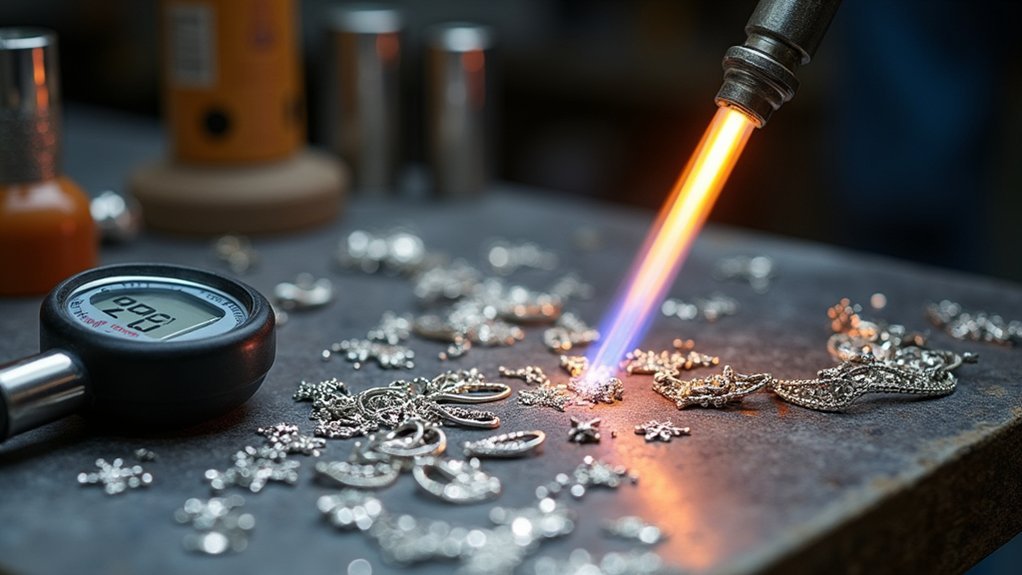
When you’re choosing between Argentium and sterling silver for your projects, understanding their distinct melting behaviors becomes essential for achieving professional results.
Argentium silver offers a wider melting range with solidus at 1410°F and liquidus at 1610°F, compared to sterling silver’s narrower range of 1475°F to 1650°F. This extended range gives you greater control during granulation techniques, making temperature management less critical and reducing the risk of overheating your work.
Argentium’s 200-degree melting range provides superior temperature control compared to sterling silver’s narrower 175-degree window for granulation work.
Sterling silver’s narrow melting range demands precise temperature control to prevent damage.
Argentium’s higher purity and unique copper-germanium-rich phase contribute to easier granulation compared to standard sterling. You’ll find that Argentium’s forgiving temperature window facilitates successful fusing processes, while sterling requires more careful monitoring to achieve ideal soldering results.
Gold Alloy Melting Points and Their Impact on Granulation
You’ll notice that different karat weights create distinct temperature challenges during granulation, with 22k and 24k gold requiring more precise heat control than 18k alloys.
Your choice of zinc-free gold becomes critical since zinc can cause oxidation issues that interfere with proper granule fusion.
Mastering heat control techniques means you’ll need to understand how copper and silver content in various gold alloys affects their flow characteristics and bonding behavior.
Karat Weight Temperature Differences
Since each gold alloy contains different percentages of base metals, their melting points vary considerably and directly impact your granulation success. Understanding these karat weight differences is essential for achieving precise temperature control during filigree work.
Here’s how different gold alloys perform in granulation:
- 14k gold melts at 1,050°F-1,200°F, offering easier temperature management but producing different color characteristics.
- 18k gold requires 1,250°F-1,500°F, providing an ideal balance between workability and precious metal content for detailed granulation.
- 22k gold demands 1,500°F-1,600°F, creating challenges due to its narrow temperature window and increased melting risk.
You’ll find that higher karat weights become increasingly malleable but also more susceptible to overheating.
Even slight temperature variations can compromise your granule bonding and final piece quality, making precise heat monitoring vital for successful results.
Zinc-Free Gold Requirements
Beyond understanding karat weight variations, selecting zinc-free gold alloys becomes paramount for achieving reliable granulation results.
You’ll find that zinc-free options like David H. Fell & Co.’s “18K Yellow Gold Standard” prevent adverse reactions during heating processes that could compromise your work.
The melting point of 18K gold ranges between 1330°F and 1470°F, providing an ideal temperature window for effective granulation without damaging the alloy’s integrity.
When you use zinc-containing alloys, you’ll encounter brittleness and poor adhesion that ruins granulation quality.
Higher karat alloys like 22K offer elevated melting points, giving you enhanced temperature control during delicate granulation work.
Understanding these melting ranges directly impacts your granulation success and the aesthetic quality of your finished pieces.
Heat Control Techniques
Three critical factors determine granulation success: precise temperature readings, controlled heat application, and understanding your specific alloy’s melting characteristics.
You’ll need different approaches for each gold alloy during soldering.
Consider these temperature ranges for ideal granulation:
- 18k gold: 1330°F to 1430°F requires careful monitoring to prevent overheating
- 22k gold: 1320°F to 1400°F offers improved workability with its wider melting range
- Argentium silver: 1410°F to 1610°F provides forgiving fusing conditions compared to sterling
Your temperature control technique directly impacts granule bonding quality.
Even slight deviations can cause inadequate fusion or complete melting of granules.
Use a reliable pyrometer and practice consistent torch movements.
The extended melting point range of 22k gold makes it particularly suitable for beginners mastering granulation techniques.
Heat Distribution Techniques for Complex Filigree Structures
When working with intricate filigree structures, you’ll face the challenge of distributing heat evenly across delicate metalwork without causing damage to adjacent components. Achieving proper heat distribution requires strategic use of precision torches for targeted heating of specific joints.
Precise heat control in filigree work demands strategic torch placement to protect delicate components while ensuring proper solder flow.
You’ll need to understand the melting ranges of your materials—knowing the solidus and liquidus temperatures of silver and gold alloys prevents accidental melting during the soldering process.
Use heat-retaining surfaces like charcoal blocks or solderite boards to maintain consistent temperatures throughout your work. Employ heat sinks such as copper tongs or metal plates to absorb excess heat from sensitive areas.
Master the spot heating technique, focusing your torch only on intended sections to guarantee precise solder flow without affecting surrounding delicate elements.
Recognizing Visual Cues During the Heating Process
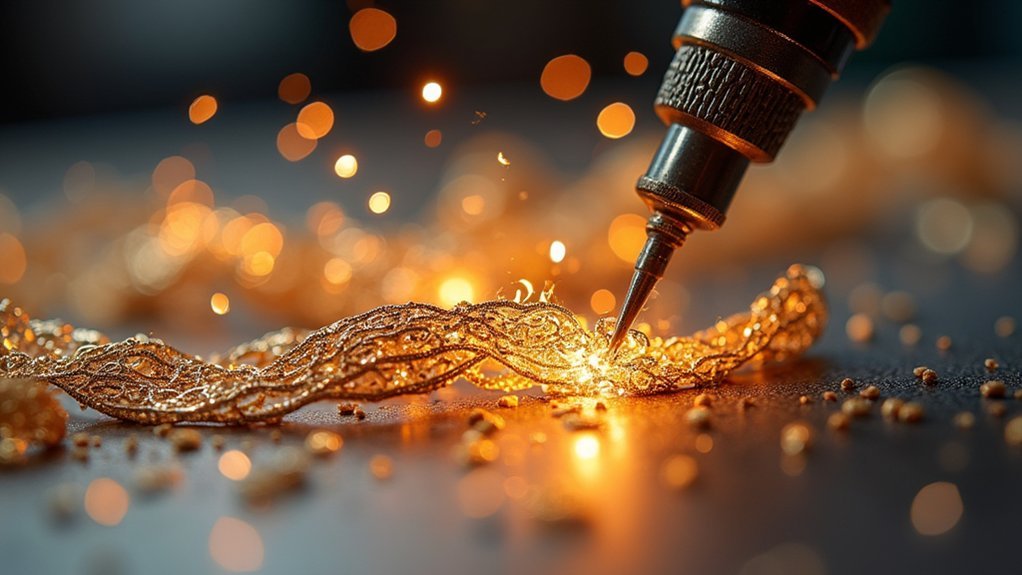
You’ll notice distinct surface color changes as your metal reaches critical temperatures—watch for the shift from dull to shiny on gold granules and the mirror-like appearance on your base metal.
These visual cues tell you when you’ve hit the sweet spot for adhesion without overheating.
Pay close attention to how the flux turns clear and glassy, as this indicates you’re ready for ideal metal flow and bonding.
Surface Color Changes
Surface color changes serve as your most reliable visual indicators during the soldering process, providing real-time feedback about metal temperature without needing specialized equipment.
You’ll observe distinct alterations as heat increases, beginning with a dull surface evolving to a bright, shiny appearance that signals proper temperature approach.
Key surface color changes to watch for include:
- Glassy or oily sheen – indicates activated flux and readiness for soldering
- Bright cherry red to yellowish hue – warns you’re approaching the melting point
- Brightening edges – confirms heat’s reaching your intended solder flow areas
Monitor these changes carefully to prevent overheating, which causes oxidation and creates dark, discolored layers requiring additional cleaning before achieving successful joints.
Metal Flow Indicators
Metal flow indicators reveal the precise moments when your solder shifts from solid to liquid, offering critical timing cues that determine joint success.
Watch for flux evolving from cloudy to clear and glassy—this signals ideal temperature for solder flow. You’ll notice a distinctive “mirror” effect appearing on the metal surface just before reaching the liquidus temperature, confirming readiness for proper bonding.
During the heating process, small bubbles forming around granules indicate you’re approaching the liquidus point.
As granules begin shrinking and coalescing into a unified mass, the fusing process is actively occurring.
Monitor color changes carefully—a bright yellow hue warns you’re nearing the melting point and must control heat precisely to prevent overheating and maintain successful joint formation.
Common Temperature Control Mistakes and How to Avoid Them
While achieving perfect granulation requires precise temperature control, even experienced jewelers can fall into common traps that compromise their results. Understanding these pitfalls will help you maintain consistent quality in your soldering work.
The most critical mistakes involve temperature management and preparation:
- Overheating beyond the melting point – Keep temperatures below your granules’ melting threshold to preserve their structure and aesthetic appeal.
- Ignoring alloy differences – Sterling silver melts at 1475°F-1650°F while Argentium silver offers a more forgiving broader range.
- Skipping flux application – Proper flux prevents oxidation and promotes clean solder flow at ideal temperatures.
Uneven heat distribution from poor torch technique can create hot spots that destroy granulation integrity.
Always practice with lower temperature settings first to understand your materials’ behavior before attempting final pieces.
Flux Selection and Its Role in Temperature Management
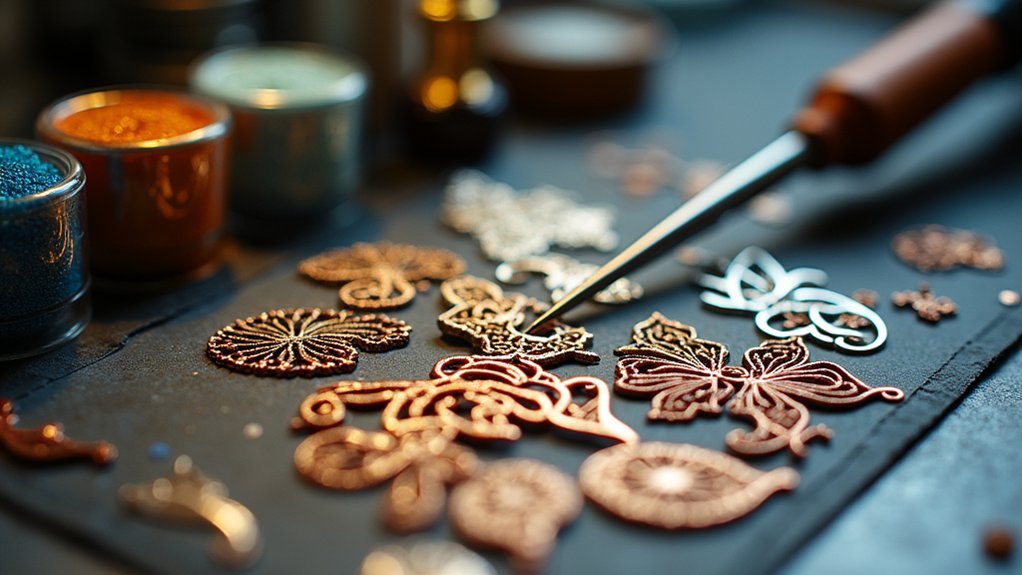
Beyond proper temperature control, flux selection serves as your secret weapon for managing heat during granulation work.
You’ll find that choosing the right flux dramatically affects your soldering temperatures and results. Liquid flux typically requires lower heat than paste alternatives, giving you better control over delicate filigree work.
Organic fluxes like Klyre Fire excel at granulation because they provide strong adhesion at reduced temperatures, protecting your base metal from overheating.
The melting range of your flux directly impacts how much heat you’ll need – low melting point fluxes enable effective soldering at gentler temperatures.
Understanding your flux’s thermal properties is essential. High melting point fluxes demand more heat, while strategically chosen low-temperature options let you work with precision and confidence.
Torch Types and Their Effect on Temperature Precision
Three primary torch types dominate the jewelry workshop, each offering distinct advantages for temperature precision in granulation work. Your choice directly impacts temperature management and the success of delicate filigree projects.
- Propane-oxygen torches deliver the highest temperatures with precise control, making them perfect for filigree granulation where temperature management is absolutely essential.
- Adjustable flame torches let you fine-tune heat output to adapt to different materials and thicknesses you’re working with.
- Focused flame torches minimize overheating risks in surrounding areas, protecting your intricate designs during soldering.
While a quality soldering iron provides consistent heat for smaller tasks, torches offer superior control for granulation work.
You’ll need to balance rapid heating capabilities with careful temperature control to avoid melting delicate details in your filigree pieces.
Creating Temperature Gradients for Multi-Component Pieces
When you’re working with multi-component pieces that combine different metals, wire gauges, and decorative elements, you’ll need to master temperature gradients to prevent disaster. Precise temperature control becomes critical when different materials require varying heat levels for proper solder flow.
Use a focused torch flame to direct heat exactly where needed while employing heat sinks like charcoal blocks to protect adjacent areas. Understanding each alloy’s solidus and liquidus temperatures guides your heating approach. Start by preheating larger sections gradually, then apply direct heat to solder joints.
| Component Type | Heating Strategy | Heat Management |
|---|---|---|
| Thick elements | Preheat first | Absorb excess heat |
| Delicate details | Shield with heat sinks | Minimal direct exposure |
| Solder joints | Focused flame application | Monitor flow carefully |
Testing and Calibrating Your Heat Application Methods
Once you’ve mastered temperature gradients, you’ll need to test and calibrate your heat application methods to achieve consistent, professional results.
Accurate calibrating guarantees your soldering temperatures reach each solder’s specific melting point without damaging delicate filigree work.
Start by practicing these essential testing techniques:
- Use temperature probes or pyrometers to measure actual heat levels in your soldering area
- Practice on scrap metal pieces to fine-tune torch settings before working on final pieces
- Experiment with different solder types to understand how each responds to varying heat application
Monitor your metal’s color changes during heating – the shift from dull to bright red indicates you’re approaching ideal soldering temperatures.
Focus your flame precisely and use controlled heating techniques to prevent uneven temperature distribution that could warp your intricate granulation work.
Advanced Temperature Control for Professional Results
Professional filigree granulation demands temperature control that goes beyond basic heat application, requiring you to master the nuanced differences between silver alloys and their specific thermal requirements. Achieving precise control means understanding that Argentium silver operates at lower soldering temperatures than traditional sterling silver, demanding careful thermal management throughout your work.
| Silver Type | Temperature Range | Visual Cues | Equipment Setting | Control Method |
|---|---|---|---|---|
| Argentium | 1410°F – 1610°F | Subtle mirror effect | Medium-low | Even heating |
| Sterling | 1475°F – 1650°F | Bright mirror shine | Medium-high | Gradual buildup |
| Fine Silver | 1760°F – 1830°F | Liquid surface | High | Quick application |
| Silver-filled | 1400°F – 1500°F | Dull reflection | Low-medium | Gentle approach |
| Recycled Sterling | 1450°F – 1625°F | Variable shine | Medium | Careful monitoring |
You’ll prevent localized overheating by heating entire pieces evenly before focusing on specific granulation areas.
Frequently Asked Questions
What Is the Best Temperature for Soldering?
You’ll want 350°F for lead-based solder or 400-450°F for lead-free types. Use lower temperatures around 300°F when you’re working with delicate components like transistors to prevent damage.
What Is the Temperature of the Soldering Process?
You’ll need temperatures between 1,300°F to 1,600°F for silver solder, depending on your alloy. Heat your base metal just below its melting point while maintaining precise control to avoid compromising granule integrity.
What Temperature Do You Need to Silver Solder?
You’ll need temperatures between 1,200°F to 1,500°F for silver soldering, depending on your specific solder type. Choose your temperature carefully since different silver solders have varying melting points for ideal joint strength.
What Is the Ambient Temperature for Soldering?
You’ll want to maintain an ambient temperature between 70°F to 75°F (21°C to 24°C) for ideal soldering conditions. This range gives you better heat control and prevents inconsistent solder flow that affects joint quality.
In Summary
You’ve now got the essential knowledge to control temperatures precisely for stunning filigree granulation. Remember, consistency is key—practice with your torch settings, monitor those critical temperature ranges, and don’t rush the process. Your 18k and 22k gold pieces will thank you for the careful attention to heat control. Keep calibrating your equipment and testing your techniques. With these skills mastered, you’ll create professional-quality granulated jewelry that showcases your metalworking expertise perfectly.

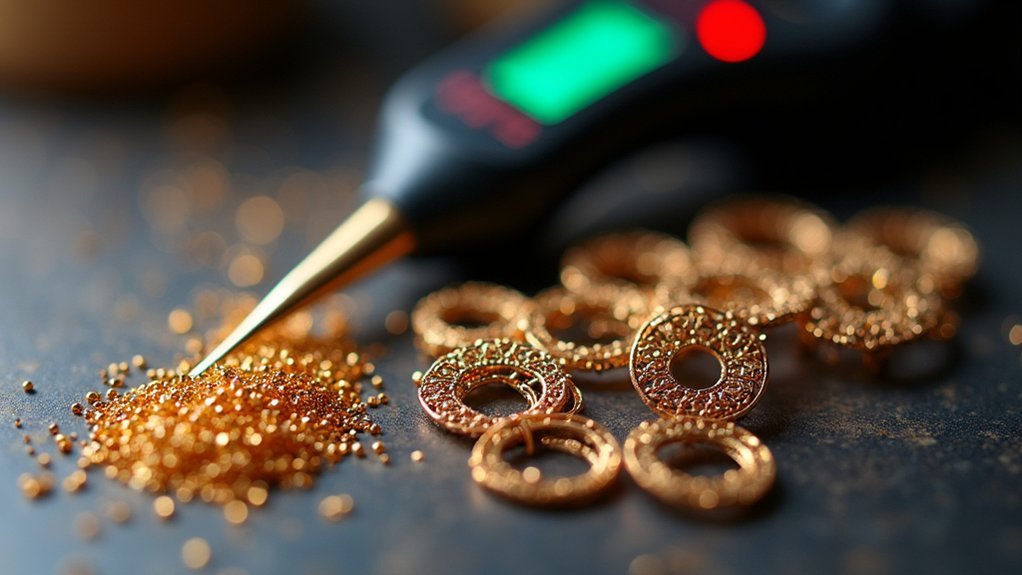
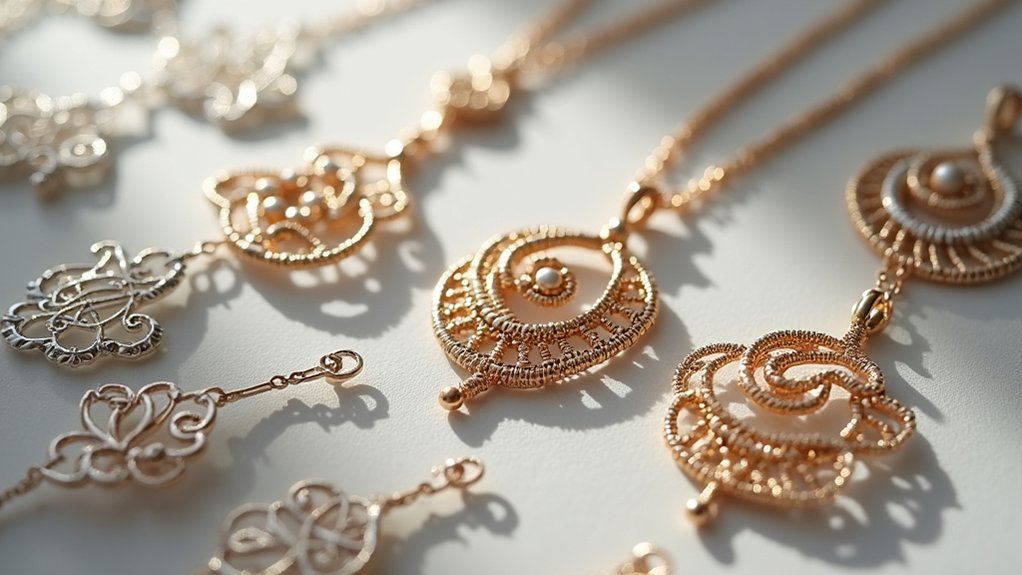
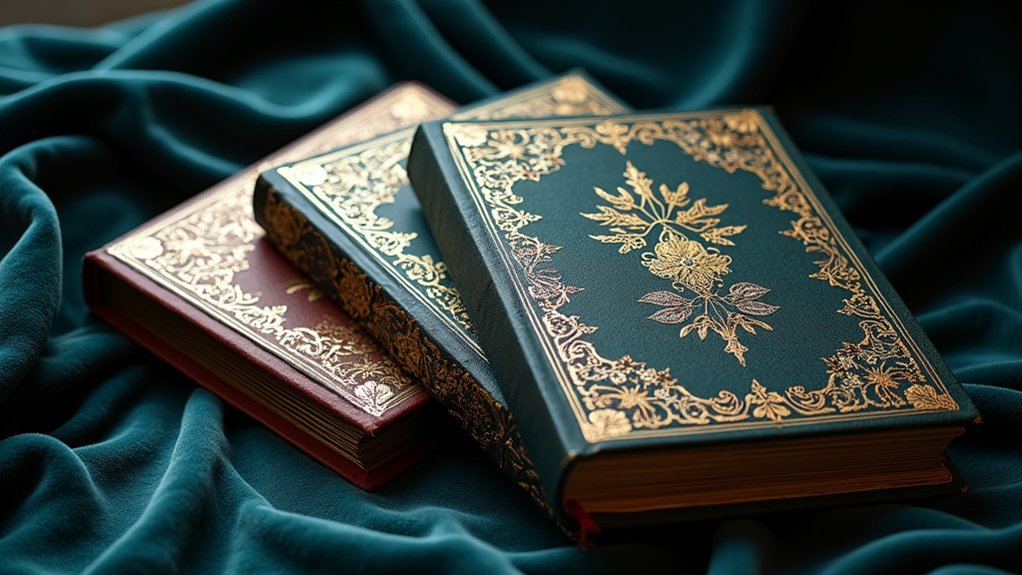
Leave a Reply